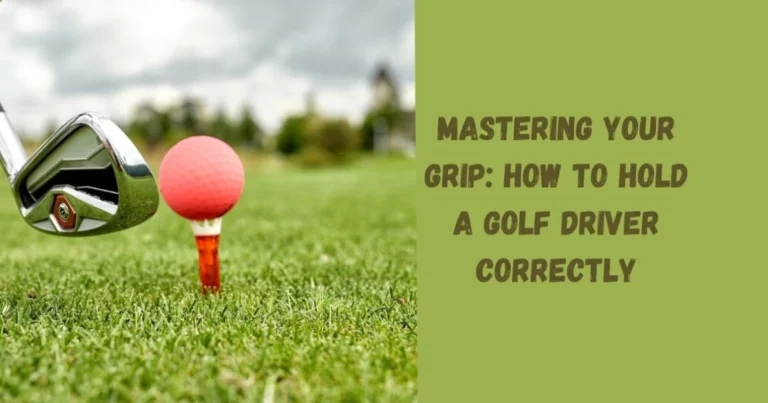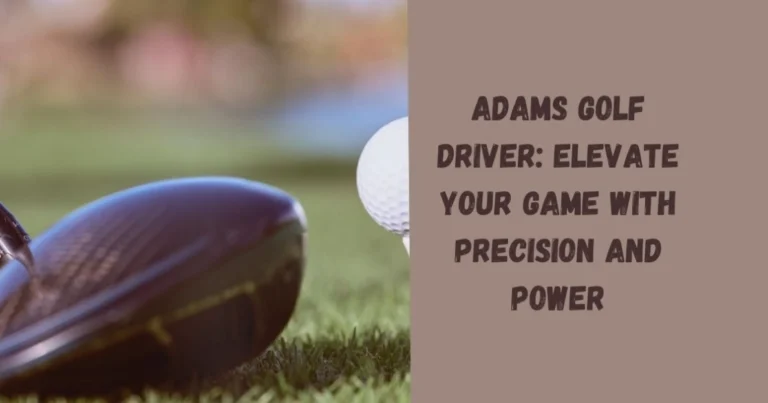Golf Driver Tips for Beginners
Starting your golf journey can be both exciting and challenging. One of the first skills to master is using your golf driver effectively. Here, we’ll explore crucial golf driver tips to help you improve your game, achieve a straight drive, and maximize your distance.
Understanding Your Golf Driver
What is a Golf Driver?
A golf driver is one of the most important clubs in a golfer’s bag. It’s designed for long-distance shots from the tee and is typically used on the first stroke of each hole. The driver has the longest shaft and the largest clubhead, allowing for maximum distance.
Importance of Choosing the Right Driver
Selecting the right driver can significantly impact your performance. Factors such as the driver’s length, loft, and material all play a crucial role in how well you can hit the ball. A well-suited driver will help you achieve better control and distance, setting the tone for the rest of your game.
Overview of Different Driver Lengths and Materials
Drivers come in various lengths and materials. The standard length for a driver is around 45 inches, but it can vary based on the manufacturer and player preference. Golf driver length affects swing speed and control; a longer driver can provide more distance but may be harder to control. Materials like titanium and carbon fiber are commonly used for driver heads due to their lightweight and durable properties.
Golf Driver Tips for Beginners
Basic Stance and Posture
Your stance and posture are fundamental to a successful drive. Stand with your feet shoulder-width apart and the ball positioned just inside your front foot. Your knees should be slightly bent, and your spine tilted away from the target. This setup helps you generate power and maintain balance throughout your swing.
How to Hold a Golf Driver Correctly
The grip is a crucial element in controlling the golf driver. To hold a golf driver correctly, place your left hand on the club first (for right-handed players), ensuring the grip runs diagonally across your fingers and the pad of your hand. Your right hand should then cover the left thumb, creating a neutral grip. This position helps maintain control and accuracy during your swing.
Importance of a Smooth Swing
A smooth, consistent swing is essential for driving the ball straight and far. Focus on a controlled backswing, bringing the club back slowly and steadily. Transition smoothly into the downswing, ensuring that your body rotates naturally. Avoid rushing your swing, as this can lead to mis-hits and loss of accuracy.
Common Mistakes to Avoid
Beginner golfers often make mistakes that can hinder their progress. Avoid gripping the club too tightly, as this can restrict your swing. Over-swinging or trying to hit the ball too hard can lead to poor contact and reduced accuracy. Keep your head steady and avoid excessive movement during the swing.
Perfecting Your Swing for a Straight Drive
Aligning Your Body and the Clubface
Proper alignment is key to achieving a straight drive. Ensure your feet, hips, and shoulders are parallel to the target line. The clubface should be square to the target at address. Use alignment aids or markers on the driving range to practice and develop a consistent setup.
Timing and Rhythm in Your Swing
Timing and rhythm play a vital role in producing a straight drive. Focus on a smooth takeaway and a controlled backswing. Your downswing should be a natural progression, with your hips leading the movement. A steady tempo helps maintain balance and control, leading to more accurate drives.
Tips for Maintaining a Consistent Swing Path
Maintaining a consistent swing path is crucial for straight drives. Practice swinging along a specific plane, ensuring the clubhead travels on the same path during both the backswing and downswing. Visual aids like alignment sticks or training aids can help reinforce this habit.
Optimizing Your Golf Driver Length and Average Distance
How to Determine the Right Driver Length for You
Choosing the correct golf driver length is essential for maximizing performance. A professional fitting can help determine the ideal length based on your height, arm length, and swing style. Generally, taller players benefit from longer drivers, while shorter players may find standard lengths more manageable.
Techniques to Increase Your Golf Driver Average Distance
Improving your golf driver average distance involves refining your technique and enhancing your physical fitness. Focus on maintaining a strong and stable posture, generating power from your legs and core. Strength training and flexibility exercises can also contribute to increased swing speed and distance.
Impact of Driver Length on Performance
Driver length can significantly impact your game. While longer drivers can potentially increase distance, they may be harder to control. Balancing distance and accuracy is crucial, and sometimes opting for a slightly shorter driver can improve consistency and control without sacrificing too much distance.
How to Use a Golf Driver Effectively
Step-by-Step Guide on How to Use a Golf Driver
- Setup: Position the ball just inside your front foot and adopt a balanced stance.
- Grip: Hold the driver with a neutral grip, ensuring both hands work together.
- Backswing: Initiate a smooth takeaway, rotating your shoulders while keeping your lower body stable.
- Downswing: Transition smoothly into the downswing, leading with your hips and maintaining a steady tempo.
- Follow-Through: Allow your body to rotate fully, finishing with your weight on your front foot and the club over your shoulder.
Drills and Practice Routines
Consistent practice is key to mastering your golf driver. Incorporate drills that focus on alignment, swing path, and tempo. Practice hitting shots with varying lengths and trajectories to develop versatility. Regular practice will help solidify good habits and improve overall performance.
Incorporating Feedback and Adjustments
Pay attention to feedback from each shot and make necessary adjustments. Use technology like launch monitors to analyze your swing and identify areas for improvement. Working with a golf instructor can provide valuable insights and personalized tips to enhance your technique.
Frequently Asked Questions (FAQs)
What is a Golf Driver and Why is It Important for Beginners?
A golf driver is a club used for long-distance shots from the tee. It is essential for beginners to master using a driver to achieve longer, straighter drives. Understanding its role and proper use can significantly enhance your game.
How Can I Achieve a Straight Drive Consistently?
Focus on aligning your body and clubface properly, maintaining a smooth swing, and practicing regularly. Consistency in setup and swing path is crucial for achieving a straight drive.
What Are Some Golf Driver Tips for Beginners to Get Started?
Start with a proper stance and grip, swing smoothly, and avoid common mistakes such as over-swinging or poor alignment. These basics provide a strong foundation for improvement.
How Do I Determine the Right Golf Driver Length for Me?
The right driver length depends on your height, arm length, and swing style. A professional fitting can help determine the optimal length, balancing distance and control.
What is the Average Distance for a Golf Driver, and How Can I Improve It?
The average distance varies by player, but focusing on proper technique, fitness, and regular practice can help improve your distance. Incorporating drills and feedback can lead to significant gains.
Mastering your golf driver is a key step towards improving your overall golf game. By following these essential golf driver tips for beginners, you can achieve a straight drive and optimize your distance, setting a strong foundation for future success. Regular practice, attention to detail, and a willingness to learn will help you develop the skills needed to excel on the course.







One Comment